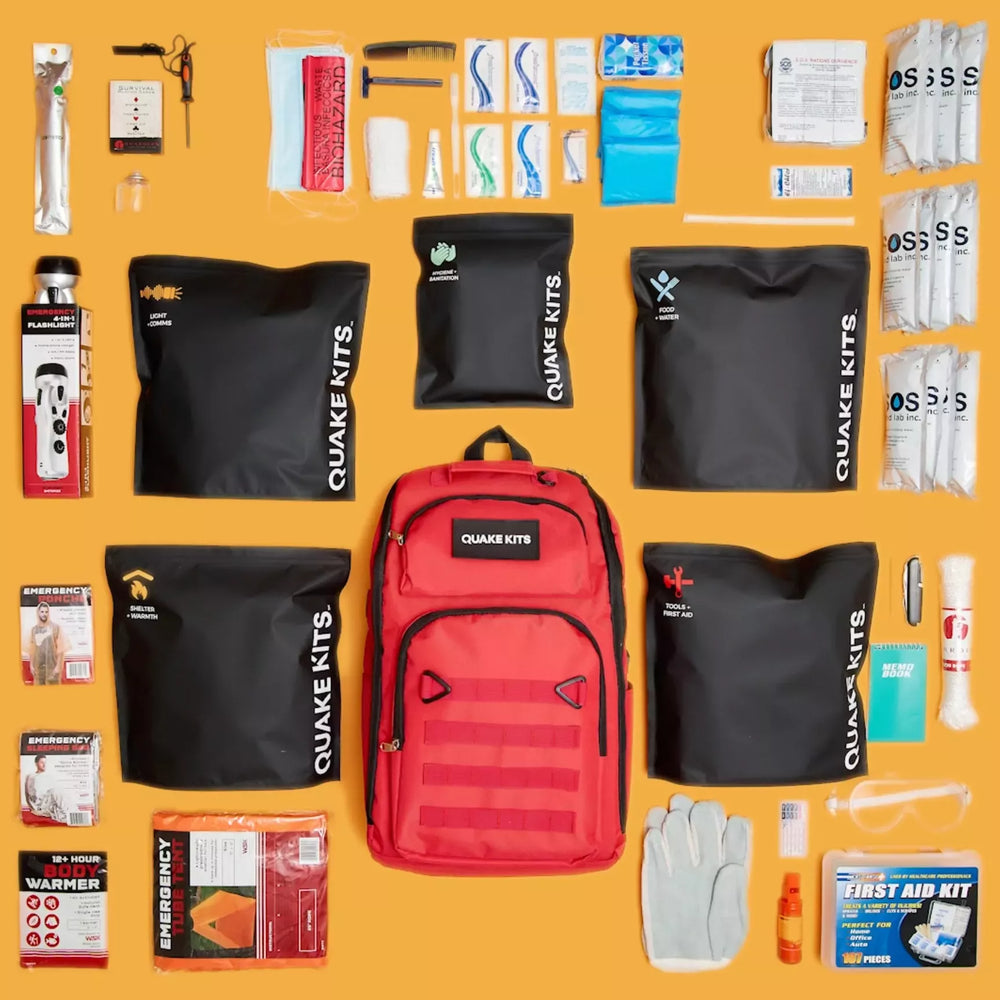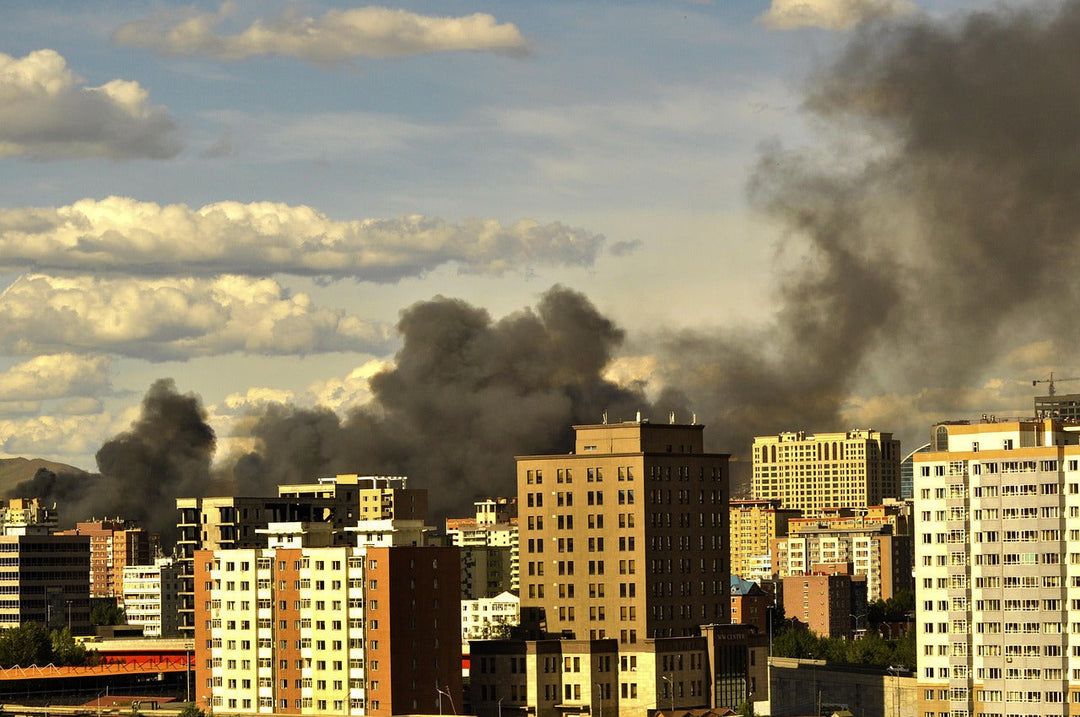Cómo prepararse para un terremoto
Esté atento a las señales de un terremoto.
Durante un terremoto se puede oír un rugido o un estruendo. Estos sonidos pueden intensificarse con el tiempo. También se puede sentir una sensación de balanceo que comienza lentamente y se vuelve violenta en cuestión de segundos.
O
Un golpe fuerte puede provocar que te estremezcas al principio. Un segundo después, podrías sentirte tembloroso y tener dificultades para mantenerte en pie o moverte por la habitación.
En cuanto algún miembro de la familia oiga o sienta este tipo de señales, deberá comenzar a poner en marcha el plan de emergencia para terremotos.
Crea un plan de evacuación
Es posible que usted y su familia tengan que evacuar una zona afectada por un terremoto. Estarán mejor preparados para responder a las señales de alerta o seguir las instrucciones de las autoridades civiles si planifican y practican la evacuación.
- Habla con tu familia sobre un plan de evacuación de la casa. Dibuja un plano de tu casa y recorre cada habitación. Analiza los detalles de la evacuación. Infórmate sobre las zonas inundables si vives aguas abajo de una represa.
- Si es posible, planifique una segunda ruta de escape desde cada habitación. Deberá marcar la ubicación de cualquier equipo especial, como una escalera de cuerda.
- Debes marcar la ubicación de tu kit de suministros de emergencia, que incluye alimentos, agua y extintores. Debes tener provisiones de comida y agua para tres días por cada persona de tu familia.
- Si es posible, localice los interruptores y válvulas de los servicios públicos para poder cerrarlos.
- Por favor, indique la ubicación de un punto de encuentro de emergencia para su familia al aire libre.
Practica qué hacer en caso de terremoto
Usted y su familia pueden practicar qué hacer en caso de terremoto.
- Si tienes hijos , involucra a toda la familia en un simulacro de terremoto. Participar en un simulacro puede ayudarte a ti y a tu familia a entender qué hacer si no estás presente durante un terremoto.
- Usted y sus hijos deben conocer los procedimientos de emergencia de la escuela en caso de desastre. Esto les permitirá coordinar cuándo, dónde y cómo podrán reunirse con sus hijos después de un terremoto.
¡AGÁCHATE, CÚBRETE Y SUJÉTATE!
- Ponte a cuatro patas. Esto te protegerá de perder el equilibrio y caerte, pero aún podrás moverte si lo necesitas.
- Cúbrete la cabeza, el cuello y todo el cuerpo debajo de una mesa o escritorio resistente. Si no tienes dónde refugiarte, busca una pared cercana o un mueble bajo para cubrirte la cabeza y el cuello. Evita ventanas y cristales que puedan romperse o cualquier objeto que pueda caerte en la cabeza.
- Sujeta la parte posterior de tu cuello con ambas manos hasta que deje de temblar.

Encuentra los lugares seguros
La mayoría de las muertes y lesiones causadas por terremotos se deben al derrumbe de materiales de construcción y a la caída de objetos pesados como estanterías, armarios y aparatos de calefacción.
- Identifica los lugares más seguros en cada habitación de tu casa. Un lugar seguro podría ser debajo de una mesa o un escritorio resistente, lejos de las paredes.
Prepare su hogar para un terremoto
Asegure sus pertenencias en su hogar.
Coloca una barandilla de metal o madera en cada estante para evitar que los objetos se caigan de los estantes abiertos. Otra opción es usar hilo de pescar.
Además, asegúrese de colocar los objetos pesados o voluminosos en los estantes inferiores. Puede fijar algunos objetos a los estantes con velcro.
Debe inspeccionar su casa y sus alrededores para detectar posibles peligros y asegurarse de protegerlos si es posible. Recuerde que cualquier cosa puede caerse, moverse o romperse durante un terremoto o sus réplicas.
- Identifique cualquier peligro potencial en la habitación. Esto incluye ventanas, objetos de vidrio, librerías y muebles sin fijar que puedan volcarse, objetos en estantes y objetos que podrían quedar bloqueados por escombros. Estos se pueden asegurar con cáncamos, escuadras o soportes en forma de L.
- Instale cerrojos deslizantes y pestillos de seguridad para niños para asegurar las puertas de los armarios.
- Puedes asegurar electrodomésticos grandes como refrigeradores, estufas y calentadores de agua con cable flexible, flejes trenzados o metálicos.
- Es recomendable bajar de la cama los espejos y fotos pesados que cuelgan sobre las camas, sillas u otras zonas donde duermes. Puedes sujetarlos con alambre usando cáncamos atornillados a la pared. También puedes colocar tornillos en la parte superior e inferior del marco y fijarlos a los montantes.
- Las cestas ligeras de plástico o mimbre pueden sustituir a las macetas colgantes de cerámica o vidrio pesadas.
- Debe identificar cualquier veneno, disolvente o sustancia tóxica en los envases rotos. Luego, trasládelos a un área de almacenamiento segura y bien ventilada. Manténgalos alejados del área de almacenamiento de agua y fuera del alcance de las mascotas y los niños.
Asegure la estructura de su hogar.
Comprueba la seguridad estructural de tu casa.
- Utilice correas en forma de "T" y "L", tornillos de solape, soportes para viguetas y tapas para postes dobles para reforzar las uniones entre vigas, postes y viguetas. Preste especial atención a la estructura expuesta en garajes, sótanos y porches.
- Inspeccione su techo y chimenea para detectar tejas o ladrillos sueltos que pudieran desprenderse durante un terremoto. Repare las tejas o ladrillos dañados si es necesario.
- Para protegerse de la caída de ladrillos de la chimenea, que podrían perforar el tejado, refuerce el techo justo alrededor de la chimenea con madera contrachapada de 19 mm (3/4 de pulgada), clavada a las vigas del techo.
Comuníquese con la oficina de desarrollo comunitario y cumplimiento del código de construcción de su gobierno local para obtener más información sobre las normas de seguridad estructural en su área. Muchas ferreterías y tiendas de mejoras para el hogar ofrecen información e instrucciones si le interesa realizar el trabajo usted mismo.
Apague todos los servicios públicos.
- Aprenda dónde se encuentran y cómo puede cortar el suministro de servicios públicos como gas, electricidad y agua en los interruptores o válvulas principales. Para obtener más información, comuníquese con su compañía de servicios públicos local.
- Todos los miembros de la familia deben aprender a apagar los servicios públicos.
- Visita Habilidades de Seguridad.
Ten a mano un kit de preparación para emergencias.
Asegúrese de tener provisiones de emergencia listas para usar en caso de terremoto. Debe contar con un botiquín de primeros auxilios , así como con provisiones de emergencia para su hogar y vehículo . Además, su lista de provisiones debe incluir agua y alimentos de emergencia, refugio y abrigo, etc. Debe tener suficientes provisiones para cada miembro de la familia para un mínimo de tres días. Armar su propio kit puede ser confuso, llevar mucho tiempo y resultar costoso. Por esta razón, hemos creado varios kits para terremotos que contienen todo lo esencial a precios accesibles.
Además, haga una lista con información importante como números de teléfono de contactos de emergencia, información sobre seguros, información médica importante, etc. (más detalles a continuación) . Guarde estos documentos en un lugar seguro, como una caja ignífuga .
artículos adicionales
Comprar un kit de supervivencia es un excelente punto de partida. Aquí tienes algunos artículos adicionales que te recomendamos añadir a tu kit.
- Identificación
- Certificados de nacimiento, matrimonio y defunción
- Decretos de adopción y custodia
- Documentos de ciudadanía
- documentos militares
- Pasaportes, visas
- Tarjeta de la seguridad social (o números de tarjeta)
- Registros de empleo
- Médico
- Registros médicos y de salud familiar
- Información sobre beneficios para empleados
- Nombre, dirección y número de teléfono del abogado, asesor financiero y agentes de seguros
- Fotocopias de documentos
- Personal
- Fotos familiares, cintas de vídeo, etc.
- Libros importantes
- historia familiar personal
- registros genealógicos familiares
- Seguro
- Duplicados de pólizas de seguro (vida, salud, automóvil, hogar, riesgos, etc.)
- Documentos hipotecarios
- escrituras de bienes raíces
- documentos de título
- Títulos de propiedad de vehículos automotores y facturas de venta, números de serie o VIN
- Testamentos y fideicomisos
- Caja de seguridad: ubicación, número, inventario del contenido, ubicación de la llave, personas autorizadas para acceder a la caja.
- Cartera de inversión
- Acciones, bonos y otros valores
- Números o certificados de cuentas bancarias, corrientes o de ahorro
- Cuentas de tarjeta de crédito (número de empresa y de cuenta)
- Zapatos adicionales y ropa de abrigo
- Un hacha
- Una pala
- Una cuerda resistente para usar en rescates o remolque.
- Extintor multiusos, de polvo químico seco






Dejar un comentario